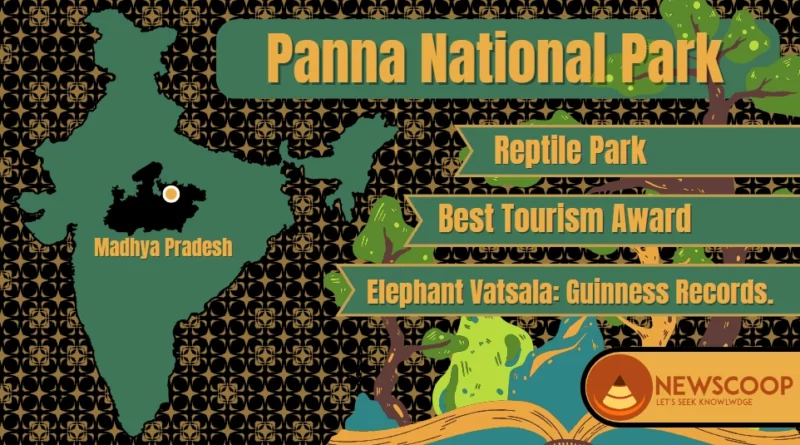Panna National Park UPSC 100% Tiger Reserve Important Facts | Biosphere Reserve
Panna National Park is a wildlife reserve located in the Panna and Chhatarpur districts of Madhya Pradesh, India. It was established in 1981 and covers an area of 543 square kilometers. The park is known for its diverse range of flora and fauna and is home to several threatened and endangered species.
The landscape of Panna National Park is characterized by lush green forests, rolling hills, and deep valleys. The park’s vegetation consists of dry deciduous forests, with a mix of teak, sal, and bamboo trees. The park’s rivers and streams are home to several species of fish, including the critically endangered mahseer.
| National Park | Panna National Park |
| District | Panna and Chhatarpur |
| River | Ken River |
| Establishment Year | 1981 AD |
| Area | 543 Sq.Km. |
| Project Tiger | 1994-95 AD (State’s fourth) |
Panna National Park
Panna National Park is known as the second “Sariska National Park” of India. Further, In the year 1981, it was established in place of Gangau Wildlife Sanctuary. Geographically, it is divided into 3 parts :
- North Talgaon Plateau
- Central Hinauta Plateau
- Ken River Canyon
The Ken River is called the lifeline of the Panna National Park. Moreover, protection is provided to crocodiles and alligators in the Ken River in the Ken Gharial Wildlife Sanctuary.
Pandav Falls, Gatha Falls, and Daudhan Falls are built on Ken and its tributaries lie in Panna National Park, which promotes the beauty of the National Park.
This is home to a wide range of wildlife, including tigers, leopards, sloth bears, and hyenas. The park also has a large population of deer, including spotted deer and sambar deer.
In addition to its large mammals, the park is also home to over 200 species of birds, including several species of vultures, eagles, and waterfowl.
Tourism is a major source of income for the local communities around this park, and the park is a popular destination for wildlife enthusiasts and nature lovers.
Visitors can go on wildlife safaris, birdwatching tours, and nature walks, and can also stay in one of the park’s several lodges and campsites.
Also Read: Kanha National Park
Animals of Panna National Park
- The only national park in India, which is famous for the conservation of wild buffaloes.
- “Reptile Park” has also been built, which is a perfect and favorable habitat for wild animals.
- Tigers, leopards, wild cats, wild dogs, hyenas, nilgai, chinkara, and wild buffalo are all wildlife animals.
- In the year 2018, the center of Panna National Park’s most prominent attraction and the world’s oldest elephant “Vatsala” has been registered in the Guinness Book of World Records.
- Elephant Vatsala:
- Elephant Vatsala is more than 100 years old and she was born in the Nilambur forest of Kerala.
- Further, Vatsala was first introduced in 1972 to the Bori Wildlife Sanctuary in Hoshangabad.
- Thereafter, in 1992, it was rehabilitated in Panna National Park.
- In 2018, “Vatsala” was made the assembly election icon of the Panna district by the Election Department.
Important Facts

- On August 25, 2011, India’s 18th and Madhya Pradesh’s third biosphere reserve (Biosphere Reserve) was established under Panna National Park.
- Moreover, the World Wildlife Fund has been established with the help of the World Bank.
- It has been given the Best Tourism Award for the year 2017.
- It has also been awarded the MP Best Wildlife Award by “Lonely Planet Group” on May 9, 2016.
- National Park is under threat due to the water logging of the Ken Betwa Link Project.
- Apart from Wild Buffalo, Reptile Park, this National Park is famous for “Aonla production“.
- Here vultures were counted in 2017 by “Organic Ion Transport Technique“.
Flora & Fauna
Flora and Fauna of Panna National Park:
| Flora | Fauna |
|---|---|
| Teak | Bengal Tiger |
| Saal | Indian Leopard |
| Jamun | Sloth Bear |
| Mahua | Indian Wolf |
| Bamboo | Indian Gaur (Indian Bison) |
| Tendu | Spotted Deer (Chital) |
| Bel | Sambar Deer |
| Arjun | Nilgai (Blue Bull) |
| Palash | Indian Wild Dog (Dhole) |
| Mango | Indian Fox |
| Amla | Indian Vulture |
| Banyan | Langur Monkey |
| Salvia | Indian Python |
| Neem | Mugger Crocodile |
| Chandan (Sandalwood) | Marsh Crocodile (Gharial) |
| Grasses and Shrubs | Various species of birds and reptiles |
Places in Panna National Park
The following are the important places in Panna National Park:
1. Raneh Falls
- Description: A stunning waterfall formed by the merging of the Ken and Khuddar rivers in the Panna Reserve area.
- Background: Named after King Rane Pratap, the former ruler of the region.
- Features: Creates a 30-meter-deep, 5-kilometer-long canyon leading to the Ken Gharial Sanctuary. The surroundings are adorned with colorful crystalline granite.
2. Ken Gharial Sanctuary
- Description: A renowned sanctuary on the outskirts of Panna, dedicated to conserving the endangered Indian Gharial species.
- Location: Established at the confluence of the Khuddar and Ken rivers in Panna, Chhatarpur district.
- Establishment: Founded in 1985 and covers an area of 13.5 square kilometers.
- Wildlife: Natural habitat for various reptile species, including the 6-meter-long fish-eating gharial. Also houses wild boar, chinkara, blue bull, peacock, and chitals. The sanctuary features a 45-kilometer river stretch with sand banks.
3. Mahamati Prannathji Temple
- Description: A popular pilgrimage site for Pranamis, particularly during Sharada Purnima.
- Legend: Mahamati Prannathji resided at this location for 11 years before entering samadhi (a deep meditative state) within one of the temple’s domes.
- Architecture: Built-in 1692, the temple showcases a fusion of Muslim and Hindu architectural styles. It consists of six parts: Shri Gummatji, Shri Bangalaji, Shri Sadguru Mandir, Shri Baijurajji Mandir, Shri Chopada Mandir, and Shri Khijada Mandir.
- Main Attraction: Shri Gummatji, a circular building with nine marble domes. Each dome represents a direction, while the central dome houses a divine golden Kalasha.
- Notable Feature: Kaman Darwaza, a well-known temple gate made of silver metal.
Conclusion
In conclusion, Panna National Park is a captivating wildlife sanctuary located in the Panna district of Madhya Pradesh, India. It is home to diverse flora and fauna, offering visitors a chance to experience the natural beauty and wildlife of the region. The park is known for its efforts in conserving endangered species, including the Indian Gharial and various reptiles.
Additionally, the park features notable attractions like Raneh Falls, which creates a stunning canyon, and the Mahamati Prannathji Temple, a revered pilgrimage site. Panna National Park is a must-visit destination for nature enthusiasts and wildlife lovers seeking an immersive and memorable experience in the heart of India.
Thank You!
What type of vegetation can be found in Panna National Park?
Panna National Park is characterized by dry deciduous forests, with a mix of teak, sal, and bamboo trees.
How is Panna National Park important for the local communities?
Tourism is a major source of income for the local communities around Panna National Park, and the park provides employment and business opportunities for the local population.
What types of tourism activities are available in Panna National Park?
Visitors to Panna National Park can go on wildlife safaris, birdwatching tours, and nature walks, and can also stay in one of the park’s several lodges and campsites.
What is the significance of Panna National Park for birdwatching?
Panna National Park is home to over 200 species of birds, including several species of vultures, eagles, and waterfowl, making it a popular destination for birdwatching.
Related Links:

